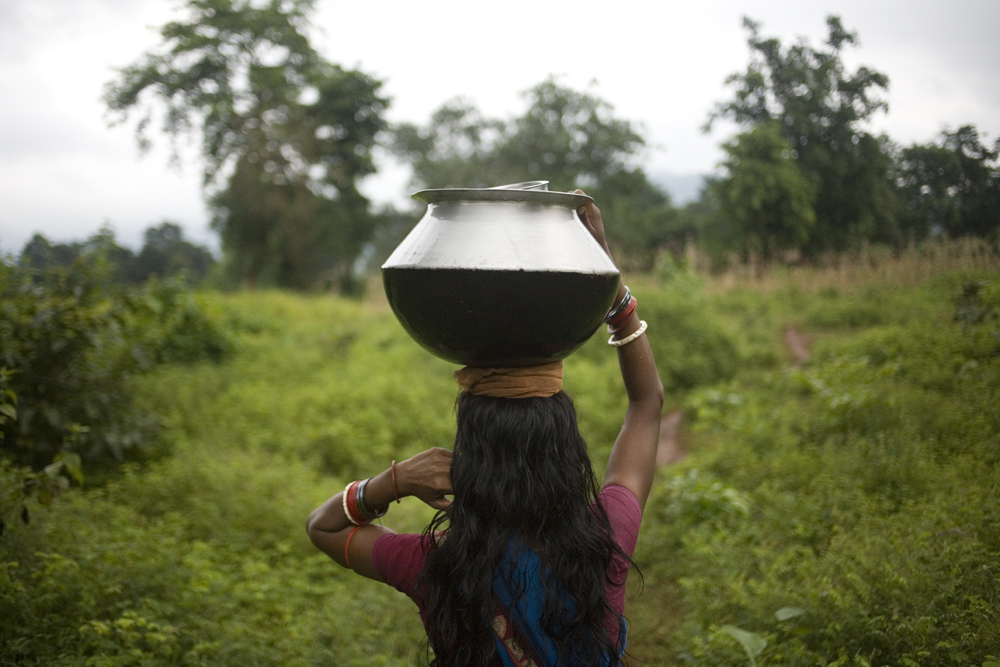Since 2001, I have been documenting the effect of industrialization on rural communities across India. This project focuses on the mining belts of Orissa and looks at how people in this region cope with a changing landscape and depleting resources.
Orissa leads the country in the production of chromite, bauxite and iron ore. For many years large Indian and multinational companies have been establishing mining operations across the state leading to the displacement of the indigenous community of Adivasis who constitute 25% of Orissa’s population. Adivasis have traditionally relied on forest and farmland for their survival, but in the last decade Orissa has cleared more forestland than any other state in India and farmland is being leased to mining companies for drilling.
In spite of the challenges of living in a polluted and deteriorating landscape, rural communities attempt to maintain their traditional way of life. I traveled with a group of Adivasis into the Niyamgiri hills who forage for food, wood and medicinal plants. Having lived in this area for generations, they have a deep knowledge and appreciation for the resources of the forest. But with the decrease in cultivable land and forest area, many Adivasis have been forced to look for work in mining companies.
The state is so rich in minerals that the government has adopted a fast track clearance system for projects investing over 6 million dollars. Yet, most villages along the mining belt still do not have access to good roads, a proper education for their children, electricity and healthcare. With company mottos such as “Envisioning Growth, Enriching Lives” or “Giving Everyone in Orissa a Reason to Smile” I am interested in the reality of the relationship between companies and local people. My intention is to continue photographing the changing way of life of communities living along the mining belt of Orissa.

Roads are piled high with waste from processed iron-ore. Sundergarh, Orissa, India.

Iron-ore is piled high ready to be loaded on to trucks for delivery to distributors and mills in Keonjhar district known for it’s huge reserves of iron-ore. Keonjhar, Orissa, India.

A mine worker carries home a chicken from the Sunday market in the Sundergarh distrct. Sundergarh, Orissa, India.

A worker in an iron-ore factory rides his bicycle home through the pollution. Sundergarh, Orissa, India.

Villagers sift through waste from chromite-ore mines in search of scraps to sell back to merchants. Many of them have been surviving this way for over 20 years. Sukinda, Orissa, India.

Sukinda town is considered to be one of the most polluted places in the world. Waste from processing chromite is dumped into quarries. Sukinda, Orissa, India.

Villagers sift through waste from chromite-ore mines in search of scraps to sell back to merchants. Many of them have been surviving this way for over 20 years. Sukinda, Orissa, India.

Waste from the second stage of bauxite processing is pumped from the Vedanta plant into a dumpsite which was previously agricultural land. Lanjigarh, Orissa, India.

Children growing up in Sukinda are being affected with many diseases as 60% of the drinking water there is polluted with hexavelnt chromium. Sukinda, Orissa, India.

Tribals in Lanjigarh, where there is huge reserves of bauxite, sacrifice a bird to the gods to protect their land and their forests. Lanjigarh, Orissa, India.

A villager takes his child to a make-shift school through a village that has been heavly mined for chromite. Sukinda, Orissa, India.

Workers carry chromite-ore to trucks at the Kamardha chromite mine. Sukinda, Orissa, India.

Villagers sift through waste from chromite-ore mines in search of scraps to sell back to merchants. Many bring their to help them. Sukinda, Orissa, India.

Communities living along the mining belts have seen their land taken by mining companies and forests depleted over the past many decades. Sundergarh, Orissa, India.

Women sweep in front of their homes in Longalata village in the chromite mining belt of Orissa. Keonjhar, Orissa, India.

Children growing up in mining towns in Orissa are affected by many diseases as pollution permeates the air and seeps into the soil. Keonjhar Orissa, India.

A worker is sick from jaundice as they do not have access to clean drinking water. Keonjhar, Orissa, India.

Bauxite extracted from the ground goes through a chemical process to separate it from the soil. Toxic effluents from this process flow into a pit. Lanjigarh, Orissa, India.

Clean drinking water along the mining belts is scarce and villagers have to travel far. Sukinda, Orissa, India.

Effluents from the Vedanta bauxite treatment plant flow into a lake. Lanjgarh, Orissa, India.
Bio:
I am photographer of Indian origin. I was born in Washington D.C. in 1967 and spent my formative years in Delhi. I moved back to the United States in 1986 to continue my further education. I began my photography career in 1999 after moving to New York.
My work has focused on communities impacted by rapid industrial growth in India. I have photographed manual laborers, from the ship-breaking yards of Bombay to the coal mining villages of Dhanbad. Other long-term stories include documentation of the toxic industrial belts in the Patancheru district of Andhra Pradesh and Ankleshwar in. My most recent project looks at Orissa where mining has altered the lanscape and stripped the area of the natural resources.
An earlier long-term project begun in 2001, explored the effect of the AIDS epidemic in India. I began by photographing patients and staff at Freedom Foundation HIV/AIDS clinics in South India, one of the first free facilities where HIV+ people could seek treatment.
